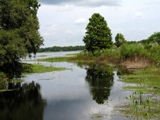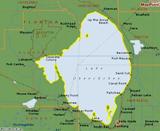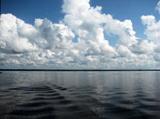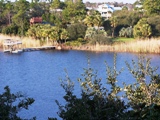Discover Florida Nature
It's time to explore the natural Florida


|
|
|
|
|
|
Florida has 2937 lakes, ponds, reservoirs, and other fishing bodies of
water to choose from. Florida's lakes and ponds are among our most
valued natural resources. Each lake in Florida is a unique combination
of ecologic, morphologic, hydrologic, and geologic qualities. Thirty-one
Florida lakes are greater than 5,000 acres. Lake Okeechobee, by far the
largest lake in Florida, and the second largest freshwater lake
contained wholly within the United States, spans more than 450,000 acres
of open lake and meandering shorelines of dense aquatic vegetation.
Eighty percent of Florida's 8,000 lakes and ponds have a surface area of
less than 100 acres From the clear sandhill lakes of the "high" Florida ridge, to the green life-filled lakes of the "valleys", each plays crucial roles in irrigation, flood control, drinking water supply, recreation, navigation, and as habitats for plants and wildlife. Several thousand of our lakes and ponds were naturally formed eons ago through geologic processes; thousands more are artificial, constructed in housing developments, shopping centers and golf courses. They vary widely in shape, depth, and size, as well as in water chemistry and quality. Lake type is determined by the manner in which lake formation took place, and by the surrounding environment. Natural lakes in Florida were formed in a variety of ways by the forces of nature; artificial lakes were formed by the forces of man. A Florida lake may be a shallow bowl of crystal clear water less than a hundred feet across, or it may be a vast, life-filled ecosystem more than 30 miles across such as Lake Okeechobee. Although most natural lakes in Florida have been physically altered in order to accommodate water management objectives, many lakes throughout the state are completely artificial. These lake water bodies are created for aesthetic pleasure, drainage, flood control, irrigation, navigation, fishing, recreation, storm water treatment, water for livestock, to provide fill material, and/or to increase property values. The watershed includes the land surrounding a lake that sheds water into the lake. Some lakes have very small watersheds, such as lakes on top of hills; some have very large watersheds, such as lakes in low areas surrounded by hills, and where water may drain into the lake from many square miles. Watershed delineation for Florida lakes is somewhat different from other parts of the country because of the state's high number of groundwater fed seepage lakes: in Florida, the aquifer watershed must also be taken into consideration. Knowing the watershed, surface area, water volume, and shoreline plant zonation of a lake basin helps us understand the lake and enables lake managers to better predict how conditions such as drought, flooding, hurricanes and development will affect the lake system. This is important because changes in water levels affect water quality, plants and wildlife, as well as the surrounding developed areas. Other aspects managers take into consideration are lake geology, hydrology, human uses, and last but not least, the "management objectives" for the lake. Types of Lake Origins:  Solution
(sinkhole) lakes- The most common origin of lake formation in
Florida is by karst erosion, a chemical process that takes place when
underground limestone is dissolved by carbon dioxide enriched water.
Most solution lakes are a result of sinkhole activity and thus are
circular, steeply sided and deeper than other Florida lakes. Shape
irregularities develop due to adjacent sinkholes or additional
subsidence. Solution lakes primarily occur in clusters. Examples are the
many connected lakes in the Tsala Apopka marsh of Citrus county and
Lakes Harris, Griffin, Eustis, and Yale of Lake County. Solution
(sinkhole) lakes- The most common origin of lake formation in
Florida is by karst erosion, a chemical process that takes place when
underground limestone is dissolved by carbon dioxide enriched water.
Most solution lakes are a result of sinkhole activity and thus are
circular, steeply sided and deeper than other Florida lakes. Shape
irregularities develop due to adjacent sinkholes or additional
subsidence. Solution lakes primarily occur in clusters. Examples are the
many connected lakes in the Tsala Apopka marsh of Citrus county and
Lakes Harris, Griffin, Eustis, and Yale of Lake County. Depressions
in ancient seabed- Some lakes are natural depressions in the ancient
limestone bedrock that were formed by wave action or water currents as
sea levels rose and fell over millions of years. Generally, these lakes
are shallow bowl-shaped water bodies that are only a few meters deep.
Except for a notable exception or two, depression lakes are generally
elongated, or appear threaded together, along the coast or near rivers.
Examples include Lake Okeechobee, Long Pond and Lakes Washington,
Winder, and Helen Blazes at the headwaters of the St. Johns river. Depressions
in ancient seabed- Some lakes are natural depressions in the ancient
limestone bedrock that were formed by wave action or water currents as
sea levels rose and fell over millions of years. Generally, these lakes
are shallow bowl-shaped water bodies that are only a few meters deep.
Except for a notable exception or two, depression lakes are generally
elongated, or appear threaded together, along the coast or near rivers.
Examples include Lake Okeechobee, Long Pond and Lakes Washington,
Winder, and Helen Blazes at the headwaters of the St. Johns river. Fluvial
development- The least common origin of Florida lakes is through
fluvial (river) processes as the river carries and deposits sediments
along the river bank. River processes can enlarge existing water bodies,
create natural levies that separate and form a new waterbody, or leave a
remnant oxbow waterbody as a river changes its course. Like depression
lakes, fluvial lakes appear elongated and occur in linear chains or as
U-shaped oxbow lakes. Examples include Lake Harney, Lake Hernando, and
Lake Monroe. Fluvial
development- The least common origin of Florida lakes is through
fluvial (river) processes as the river carries and deposits sediments
along the river bank. River processes can enlarge existing water bodies,
create natural levies that separate and form a new waterbody, or leave a
remnant oxbow waterbody as a river changes its course. Like depression
lakes, fluvial lakes appear elongated and occur in linear chains or as
U-shaped oxbow lakes. Examples include Lake Harney, Lake Hernando, and
Lake Monroe. Coastal
dune lakes- Coastal dune lakes are the result of long shore currents
that deposit sediments along a coastal inlet or bay. Eventually, water
in the inlet or bay is cut off from the sea and a saltwater waterbody is
created. As the lake becomes increasingly landlocked and saltwater
intrusion ceases, a freshwater lake is formed. However, hurricane
activity can create intermittent periods of salinity. Examples of
coastal dune lakes primarily occur in the Panhandle and include Camp
Creek, Draper Lake, and Big Red Fish Lake. Coastal
dune lakes- Coastal dune lakes are the result of long shore currents
that deposit sediments along a coastal inlet or bay. Eventually, water
in the inlet or bay is cut off from the sea and a saltwater waterbody is
created. As the lake becomes increasingly landlocked and saltwater
intrusion ceases, a freshwater lake is formed. However, hurricane
activity can create intermittent periods of salinity. Examples of
coastal dune lakes primarily occur in the Panhandle and include Camp
Creek, Draper Lake, and Big Red Fish Lake.Extraterrestrial influenced lakes- Some of our lakes may have been formed by meteorites slamming into Earth, which is suggested for the formation of Ocean Pond in Baker County. |
|
|
Advertise | Privacy Statement | Dog Encyclopedia | Video |Contact | Alaska Nature |
|